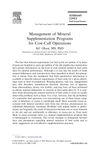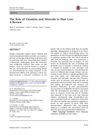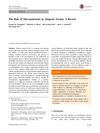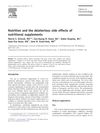TLDR Dogs with epilepsy have different hair mineral levels than healthy dogs, possibly due to epilepsy or its treatment.
The study analyzed hair samples from 63 dogs with idiopathic epilepsy (IE) and 42 healthy controls, finding significant differences in mineral and trace element concentrations. Dogs with IE had lower phosphorus and higher levels of copper, zinc, selenium, and arsenic, with a higher copper/zinc ratio. These differences were more pronounced in dogs treated with antiseizure drugs, particularly potassium bromide, which was associated with elevated arsenic levels. The findings suggest that trace element imbalances may play a role in the pathophysiology of IE in dogs, and hair analysis could be a useful method for assessing long-term trace element status. Further research is needed to explore the impact of these imbalances on epilepsy development and management.
3 citations
,
April 2023 in “Journal of Veterinary Internal Medicine” Dogs with epilepsy have different hair mineral levels than healthy dogs, possibly due to epilepsy or its treatment.
 84 citations
,
February 2013 in “Clinica chimica acta”
84 citations
,
February 2013 in “Clinica chimica acta” Hair mineral analysis might help diagnose diseases early, but standard methods are needed.
 15 citations
,
July 2012 in “Biological trace element research”
15 citations
,
July 2012 in “Biological trace element research” Higher hair calcium to magnesium ratios and lower chromium levels in hair may indicate insulin resistance in Korean men.
 15 citations
,
January 1971 in “Journal of animal science/Journal of animal science ... and ASAS reference compendium”
15 citations
,
January 1971 in “Journal of animal science/Journal of animal science ... and ASAS reference compendium” Hair analysis can't determine ponies' calcium and phosphorus levels; use soil and feed tests instead.
 16 citations
,
March 2007 in “The Veterinary clinics of North America. Food animal practice”
16 citations
,
March 2007 in “The Veterinary clinics of North America. Food animal practice” Proper mineral supplementation in cow-calf operations prevents health issues and economic losses.
 134 citations
,
December 2018 in “Dermatology and Therapy”
134 citations
,
December 2018 in “Dermatology and Therapy” Some vitamins and minerals like vitamin D and iron can help with certain types of hair loss, but more research is needed for others.
 63 citations
,
May 2017 in “American Journal of Clinical Dermatology”
63 citations
,
May 2017 in “American Journal of Clinical Dermatology” People with alopecia areata often have lower levels of vitamin D, zinc, and folate, but more research is needed to understand if supplements can help treat it.
 January 2022 in “Bio web of conferences/BIO web of conferences”
January 2022 in “Bio web of conferences/BIO web of conferences” The conclusion is that normal trace element levels in newborn calves' hair are between the 25th and 75th percentiles, and levels outside this may indicate diselementosis.
 24 citations
,
June 2010 in “Clinics in Dermatology”
24 citations
,
June 2010 in “Clinics in Dermatology” Taking too many vitamin and mineral supplements can cause serious health problems.







